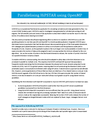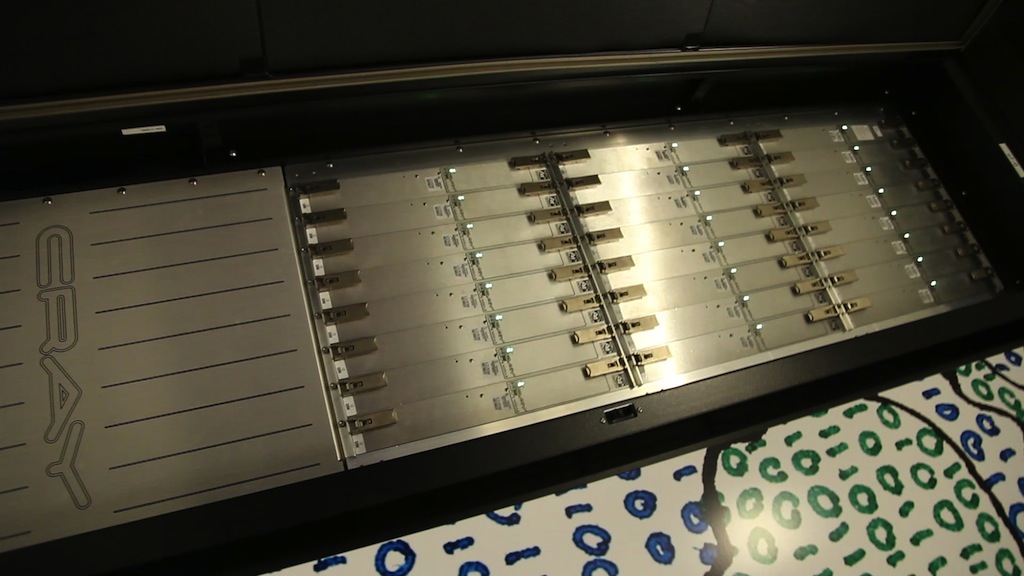
Complete Cray Centre of Excellence Projects
HiGEM (Climate Change)
HECToR is used extensively to research the Earth's climate, the National Centre for Atmospheric Sciences (NCAS) are making predictions that feed into the IPCC reports that influence government policy. Over the last decade the ARGO project has released automatic observation floats into the oceans which has dramatically improved the quantity and coverage of measurements. Oceans have a large influence on the global climate, storing heat from the sun and transporting around the world, so to test the accuracy of the computer predictions, this project compared its predictions with this newly observed data for large scale phenomena like El Nino and El Nina. The steering committee granted NCAS 30 Million AUs to this project.
Running these climate models produces very large amounts of data which has to be written to disks however the original model stops processing while it waits for this to occur. The Cray Centre of Excellence provided NCAS with a modified version of the climate model that allows scientific calculations to continue during the output, which allowed the model to run 10% faster. This improvement will increase the number of simulations that can be run on HECToR in this project and can benefit to many other scientists who use HECToR to model the climate.
HELIUM (Quantum Mechanics)
Quantum mechanics describes phenomena on the smallest scales and while the simplest quantum mechanical cases can be understood using pen and paper when many particles are involved or there is a large amount of energy a new approach are required. One of the simplest non-trivial cases is the interaction between laser light and the two electrons in a helium atom which is being studied by researchers at Queen's University, Belfast. The laser energises the electrons which then interact to reveal their quantum nature, increasing the intensity of the laser increases the amount of energy in the system and the range of phenomena. Simulating these systems requires detailed precision which requires many intense calculations. The greater the intensity of the laser the greater the range of movement of the electrons requiring very large simulations which can only be run on systems like HECToR. The Steering Committee granted Queen's University 10 Million AUs to perform the largest simulations of helium ever done using 16,000 processors of the Cray XT4 at a time. These were the interactions between helium and high intensity laser light and provide predictions which are at the limits of what experimentalists can test.
Using so many processors generates large volumes of data that has to be stored on disk, so the the Steering Committee also tasked the Cray Centre of Excellence improving the way data was handled in the application. Originally the application would stop calculating and wait for data to be written to disk, however the code was adapted to use a method that allowed calculation to continue while data was being written out. This technique was successfully demonstrated on very large numbers of processor, from 10,000 to 100,000 and was presented to the Cray User Group in Edinburgh in May 2010.
HiPSTAR (Jet Engine Noise)
The noise from jet engines can have significant impact on the quality of life of those living near airports and under flight paths. Though manufacturers have managed to reduce noise from modern engines any further reductions require a deeper understanding of the source of the noise. The School of Engineering Sciences at the University of Southampton are using HECToR to model turbulence in the fast moving jet stream as it leaves the engine with their application HiPSTAR. The turbulence is widely thought to be the source of much of the noise and the Steering Committee granted 2 Million AUs through the Centre of Excellence to begin studying the problem in detail.
The turbulence being studied occurs on many different scales, so simulations have be at very high resolution and cover large areas to make sure they cover all the features. Such simulations are very large and can only be performed on a very large computer like HECToR. To aid the research the Steering Committee engaged the Cray Centre of Excellence to optimise HiPSTAR so it would generally run faster and also to allow it to run faster by spreading work over even more parallel processors. The first led to an improvement led to the code running 8% faster while the second allowed the code to run on 6 times as many processors with the associated decrease in run times.
A second, follow up project, adapted HiPSTAR to use shared memory parallelism using the OpenMP API. This allows HiPSTAR to run the same problems using many more cores than was previously possible with test running up to 24 576 on HECToR's Cray XE6. The change also allowed HiPSTAR to run more efficiently on the same number of cores, achieving between 10% and 50% improvements in core for core performance. Both of these changes allow HiPSTAR to solve larger problems, faster than it ever could before.





